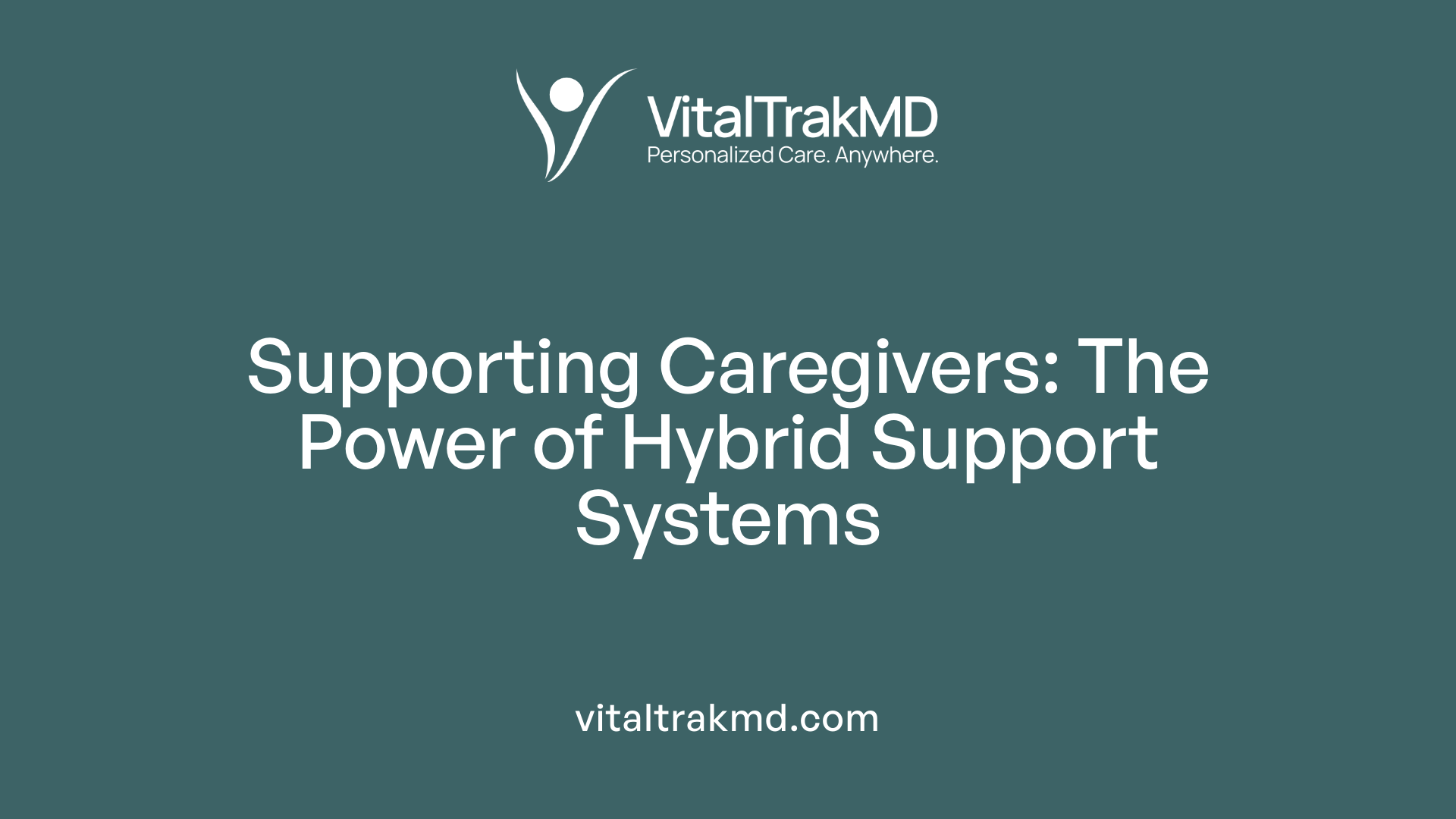How Hybrid Health Programs Support Caregivers of Seniors

Innovative Support for Seniors and Their Caregivers
As the demand for elder care escalates, hybrid health programs emerge as a pivotal solution to support both seniors and their caregivers. Blending traditional in-person services with cutting-edge digital technologies, these models foster accessible, efficient, and comprehensive care environments. In this article, we explore how hybrid health systems are transforming caregiving, overcoming barriers, and enhancing the well-being of caregivers, especially amid ongoing healthcare challenges.
Understanding Hybrid Health Programs and Their Role in Supporting Caregivers

What are hybrid health programs, and how do they support caregivers of seniors?
Hybrid health programs blend traditional in-person healthcare services with modern digital health technologies. They utilize tools such as telehealth, remote patient monitoring, advanced pillboxes, fall alert systems, and virtual communication platforms to create flexible and accessible care options.
For older adults, these programs often include virtual classes and social engagement activities that can be accessed from home. This allows seniors to stay connected, participate in health education, and maintain social interactions even if they are unable to leave their homes. This approach not only supports the physical health of seniors but also enhances their mental and emotional well-being.
Caregivers benefit significantly from hybrid health models as well. They can rely on remote monitoring and telehealth consultations to monitor their loved ones' health status, schedule appointments more easily, and receive guidance without frequent trips to healthcare facilities. Programs like hybrid home care combine technology with traditional caregiving, filling gaps in care, especially overnight or during busy times.
Community partnerships further strengthen these efforts. Collaboration with local organizations, youth, and retired professionals helps improve digital literacy among seniors and caregivers. These collaborations foster a sense of community and support, essential for holistic caregiving.
The COVID-19 pandemic accelerated the adoption of hybrid models, highlighting their ability to bridge healthcare disparities—particularly in rural or underserved areas—and promote equitable access to care. Overall, hybrid health programs aim to improve health outcomes, reduce caregiver stress, and facilitate the aging-in-place process, making support more adaptable to individual needs via innovative, technology-driven solutions.
Varieties and Models of Hybrid Solutions in Elderly Care

What types of hybrid health and home care solutions are available for caregivers of seniors?
Hybrid health and home care options blend technology with traditional in-person services to support the growing needs of older adults. These solutions aim to improve access, enhance safety, and reduce costs while easing caregiver responsibilities.
One common form is telehealth, allowing seniors to consult with healthcare providers remotely via video calls. This reduces the need for travel and enables faster access to medical advice. Remote monitoring devices—such as fall alert systems, heart rate monitors, and activity trackers—provide real-time data to healthcare teams, facilitating timely interventions.
Digital tools like online appointment scheduling, medication reminders, and communication platforms foster better coordination among caregivers, family members, and healthcare providers. These tools help ensure that seniors receive consistent and personalized care.
Advanced hybrid models incorporate artificial intelligence (AI) to support continuous care. For instance, virtual home care systems powered by AI, like Addison Care, provide remote support for medication management, emergency alerts, and daily activity monitoring. Such systems can simulate human interactions, offering companionship and alerting caregivers of unusual patterns.
Post-hospitalization, hybrid approaches include telemonitoring and virtual check-ins, allowing healthcare providers to monitor recovery from home. Wearable devices track vital signs and activity levels, enabling early detection of complications.
Overall, these integrated solutions not only foster aging in place but also support caregivers by providing safety nets and reducing physical and emotional burdens. With ongoing technological advancements, hybrid elder care is evolving into a comprehensive, accessible, and cost-effective approach that caters to diverse needs in various care settings.
Benefits and Challenges of Implementing Hybrid Programs in Elderly Care

What are the benefits and challenges of hybrid health programs in elderly care?
Hybrid health care models, which combine in-person visits with telemedicine and other technological solutions, offer numerous advantages for older adults. One of the primary benefits is improved access to healthcare services. Patients with mobility issues or those living in remote areas can receive consistent care without the burdens of travel. During the COVID-19 pandemic, hybrid visits proved especially vital, maintaining higher engagement levels than solely in-person services.
Enhancing continuity of care is another significant benefit. Through multiple communication channels, healthcare providers can monitor chronic conditions more effectively, adjust treatments promptly, and reduce hospital readmissions. Additionally, these models support healthcare efficiency by decreasing wait times and lowering overall costs associated with transportation and facility visits.
Importantly, hybrid approaches can help bridge disparities in healthcare access. Studies indicate that utilization rates are similar across different racial and ethnic groups, demonstrating their potential to promote equitable care. Furthermore, offering flexible options aligns with patient preferences, fostering higher satisfaction.
However, implementing these programs also faces some challenges. Integrating various digital systems—such as remote patient monitoring, fall alerts, and telehealth platforms—requires substantial technical infrastructure and ongoing support. Healthcare staff need adequate training to operate new technologies and adapt to changing workflows, which can be resource-intensive.
Moreover, managing complex care pathways across multiple modalities demands careful coordination. Ensuring data security, maintaining patient privacy, and addressing disparities in technology literacy among older adults are additional barriers.
To overcome these hurdles, healthcare organizations must engage in meticulous planning. This includes investing in staff training, developing interoperable systems, and establishing protocols to support both patients and providers. When effectively executed, hybrid care models can significantly enhance the quality and accessibility of elderly care.
Enhancing Caregiver Wellbeing through Hybrid Support Systems

How do hybrid health programs impact the wellbeing of caregivers and their support mechanisms?
Hybrid health programs are transforming the way caregivers receive support by blending in-person and digital services to meet their diverse needs. These programs play a vital role in improving both mental and physical health for caregivers, providing flexible access to resources that might otherwise be difficult to reach.
One of the primary benefits of hybrid programs is their ability to reduce stress and feelings of isolation, which are common among caregivers. For instance, support groups like the Holy Cross Caregiver Support Groups operate in hybrid formats, offering both face-to-face meetings and online sessions via platforms such as Microsoft Teams. This approach allows caregivers to participate regardless of their location or schedule constraints, fostering a sense of community.
In initial stages, in-person interactions help establish strong bonds, build trust, and familiarize caregivers with digital health tools. Once comfortable, they can access remote services such as online mindfulness exercises, virtual coaching, or health monitoring, which provide ongoing support beyond the physical meetings.
The flexibility of hybrid models makes it easier for caregivers to consistently engage with support systems. This can greatly improve resilience, reduce burnout, and promote healthier aging practices both for the caregivers themselves and those they care for.
Support mechanisms through digital platforms
Digital platforms are central to hybrid programs, enabling real-time communication and resource sharing. These platforms facilitate remote monitoring, telehealth consultations, and educational classes, thus creating continuous support loops.
Technology also helps caregivers stay connected, participate in virtual support groups, and receive timely information about caregiving strategies. For example, mHealth interventions reviewed in recent studies have shown promise in connecting caregivers with supportive services, improving mental health, and easing caregiving burdens.
Furthermore, agencies adopting frameworks like the VA’s Replicating Effective Programs (REP) are successfully scaling caregiver training and support initiatives through virtual mediums, ensuring broader reach and sustainability.
Impact of hybrid programs on stress and isolation
The combination of in-person and online options helps in reducing caregiver stress and mitigating feelings of isolation. During COVID-19, the rapid adoption of hybrid models ensured continuous access to support, which was crucial for maintaining mental health.
Caregivers report positive responses to these interventions, noting improvements in well-being, reduced burdens, and increased confidence in caregiving tasks. In addition, hybrid solutions provide timely safety nets, such as remote fall alerts or medication reminders, which address specific risks associated with aging.
Overall, integrating hybrid care models enhances the support ecosystem, empowering caregivers to care more effectively while nurturing their own health and resilience. This dual approach of physical presence complemented by digital connectivity is essential in fostering a sustainable, accessible, and compassionate caregiving environment.
Research Findings and Policy Perspectives on Hybrid Elder Care
What does research say about the effectiveness of hybrid health programs in senior caregiving?
Recent studies highlight the promising outcomes of hybrid health interventions for older adults. These programs typically combine in-person activities with telemedicine or digital tools, aiming to improve health and safety while increasing accessibility.
For instance, a study involving 181 frail seniors demonstrated that a hybrid exercise program incorporating Wu Qin Xi, strength training, and endurance work resulted in significant health benefits. Participants showed an average increase in walking speed and nearly 42% of them moved out of frailty after 24 weeks.
Tele-education initiatives have also been effective. Programs focused on dementia care improved health-related knowledge among caregivers and older adults, who valued the convenience and tailored content.
Engagement and inclusion in program design improve outcomes. When seniors participate in co-creating solutions, they are more likely to stick with the interventions. Furthermore, machine learning models, like stacking algorithms, are now used to predict which individuals are most likely to benefit from specific programs, allowing for personalized approaches.
Policy measures at regional and national levels further support hybrid models. These include expanding telehealth services, investing in digital literacy, and standardizing evaluation protocols. Such policies aim to make hybrid elder care more equitable, accessible, and effective.
Overall, research confirms that hybrid health programs can significantly enhance senior well-being, reduce disparities, and support aging in place when integrated into broader health policies and community services.
The Future of Elderly Care: Embracing Hybrid Innovation
As healthcare systems continue to evolve, hybrid health programs represent a promising path toward more equitable, personalized, and effective care for seniors. By seamlessly integrating technological advances with traditional support, these models empower caregivers, improve patient outcomes, and help bridge existing disparities. Continued research, policy support, and community engagement are essential to optimize hybrid systems, ensuring they adapt to diverse needs and foster sustainable, compassionate elder care for generations to come.
References
- Comparing In-Person Only, Telemedicine Only, and Hybrid ...
- What are “Hybrid” Home Care Solutions, and Might They ...
- mHealth Interventions to Support Caregivers of Older Adults
- Replicating an effective VA program to train and support family ...
- A multi-site randomized trial to test the Adult Day Service ...
- Caregiver Support Groups | Trinity Health System
- Number of Family Caregivers Supporting Older Adults ...
- What Is Hybrid Healthcare? | Tools, Benefits, and Solutions
- Comparing In-Person Only, Telemedicine Only, and Hybrid ...
Recent articles
Want to Feel Better and Live Healthier?
Join hundreds of patients taking control of their health with personalized care that fits their life – not the other way around.
Rated 4.8/5 by 32+ customers







